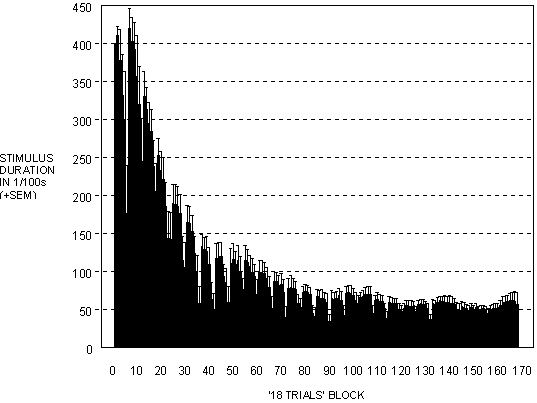
A novel nine-choice serial reaction time paradigm in rats: effects of nicotine on titrated performance
W.H.I.M. Drinkenburg1, R. Roobol2, A.B. Keith3, A. Sahgal3 and J.S. Andrews1
1 Organon
Laboratories Ltd., Newhouse, Lanarkshire, United Kingdom
2 NICI, University of Nijmegen, Nijmegen,
The Netherlands
3 MRC Neurochemical Pathology Unit,
Newcastle-upon-Tyne, United Kingdom
Serial reaction time tasks are valuable paradigms for studying attentional processes and deficits. In contrast to the five-choice serial reaction time paradigm, to our knowledge no study has been published wherein attentional performance of rats was challenged by presenting nine choices. Our study investigated in rats whether a nine choice paradigm can yield consistent performance and is sensitive to pharmacological manipulation by nicotine.
Male random bred rats (Charles River, UK) were maintained at 85% of their free-feeding weights (425-590g). Training and testing was done in chambers (25x25cm) each with one concave wall with 9 apertures, each 2.5cm square, 4cm deep and set 2cm above floor level. Holes were equipped with photocell beams monitoring nose entrance and could be occluded by a metal cap. Precision food pellets were delivered at the opposite side of the box into a photocell-monitored foodtray. The holes and the magazine could be illuminated (green multifocal LED, RS) and each box had a roof-mounted house-light. Boxes were separately housed in a dark, soundproof compartment, ventilated by low-noise fans. Procedure and data collection were controlled by in-house-developed software (Arachnid; Paul Fray).
The behavioral procedure consisted of five phases:
Variables analyzed included accuracy, latency-to-response, latency-to-magazine-visit, anticipatory responses; preservative responses; errors-of-omission. Drug administration: Nicotine (0.0; 0.05; 0.2; 0.8 mg/kg; n=6) was administered intraperitoneally 30 minutes prior to behavioral testing.
The acquisition curve of this task is shown in fig. 1: after three weeks of training in phase 5, animals obtained a mean stimulus duration of 0.544s (sem 0.0478s; range 0.30s-0.75s). None of the doses of nicotine had effect on performance, which suggests that animal’s performance was both stable and optimal.

The nine-choice-serial-reaction-time task is a well-controlled paradigm that allows usual manipulations of attentional load (e.g., ITI variability; stimulus characteristics) as well as new protocols to quantify other aspects of attention (e.g., sustained) in rats.

Poster presented at Measuring Behavior '98, 2nd International Conference on Methods and Techniques in Behavioral Research, 18-21 August 1998, Groningen, The Netherlands